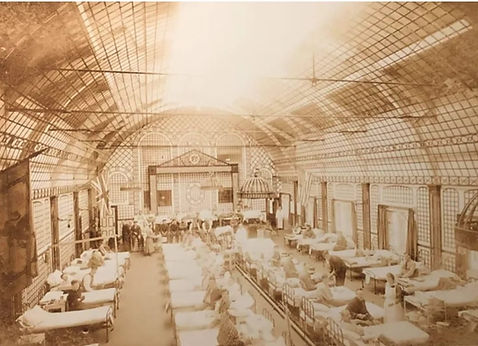HISTORY OF THE PAVILION AND SPA ESTATE

PAVILION
Strathpeffer Pavilion was commissioned in 1881 by the 1st Countess of Cromartie
(also known as Anne Sutherland - Leveson Gower, Duchess of Sutherland
as part of the creation of Strathpeffer as a Victorian Spa Village. Visitors, including
royalty and members of high society. Dubbed "the Quality" by locals – they came
to the village to “take the water”, which was said to have health benefits.
The Pavilion, with its attendant Pump Room, went on to provide entertainment
for these visitors, including lectures delivered by George Bernard Shaw,
Ernest Shackleton and Emmeline Pankhurst.
AMERICAN NAVAL HOSPITAL ( NAVAL BASE 2 )
During the first World War, the pavilion was used as a hospital for US Navy sailors, and buildings in the village were again requisitioned by the military during World War II.
After the War, the popularity of the Spa declined and the Pavilion fell into disrepair. In the late 1950s, due to the rise in popularity of motorcar and coach travel and to changes in tourism trends, Strathpeffer once again became a destination in its own right. The Pavilion was bought by a private owner, restored and refurbished, and reopened in 1960 as an events hall and concert venue. The Pavilion set the stage for gigs by the Bay City Rollers, the Fortunes, Nashville Teens and Brian Poole and the Tremeloes.
The Pavilion was then bought by a large hotel group to provide a venue to attract and entertain guests and locals, supporting the hotel trade. The advent of television, the development of Overseas Package Holidays and the recession in the 1970’s had a detrimental impact on the attraction of the Pavilion as a venue and consequently Strathpeffer as a tourist destination. By 1985 it was being used as an indoor football pitch by hotel staff.
The Pavilion lay almost unused thereafter before being bought by Highland Council and transferred to the Scottish History Buildings Trust (SHBT). The SHBT restored the Pavilion to its former glory in 2004 at a cost of £2 million from Council, HIE, Heritage and Lottery funding, and European funding.
The Strathpeffer Pavilion Association Ltd (SPA) took up the lease of the Pavilion when it reopened in 2004. However, SPA struggled to make operating surpluses and by 2015 the charity was in financial trouble.
Following the cessation of trading by SPA, the SHBT proposed to sell the building on the open market. There was regional and national coverage of the perceived threat of transfer to a private owner, and a strong desire for the Pavilion to remain a local community asset.
The building was then leased from SHBT to Highland Council; In turn the Council’s arms-length Culture and Leisure Charity, High Life Highland (“HLH”), was asked to take on the management and operation of the venue from March 2017 for a period of three years. The purpose of the three year ‘window’ by SHBT was to allow the community time to put together a strong case for community ownership and to raise the necessary funding to make the purchase.
The Strathpeffer Pavilion Community Steering Group led the work to bring the Pavilion back into community ownership and in 2020 with funding from the Scottish Land Fund, the newly formed SPCT took ownership of the Pavilion from the SHBT.








VICTORIAN GARDENS
The Spa Gardens, Strathpeffer, are a Designated Landscape, being an unusual example of pleasure grounds laid out as a part of the 19th century health resort. The designations for their Historical, Arboricultural, Architectural, and Scenic values are all “High” due to the collection of exotic specimen trees and the presence of the gardens as an integrated feature in the landscape. Originally the Gardens included a croquet lawn behind the Pavilion, a Bowling Green, and a Curling Rink which was replaced by Tennis Courts.
The Gardens were sold in 1949 to the owner of the Ben Wyvis Hotel, and suffered the same decline in the subsequent years as the Pavilion itself. The Gardens were transferred to the Highland Council in the 1996. The Council carried out a significant planting programme and environmental works in the Gardens in 2008 and for the subsequent three years. However, as council funding for all green spaces was substantially reduced, the Gardens have been co-managed over the last several years by a volunteer Gardens group.
In 2020 the ownership of the Gardens were transferred from Highland Council to the SPCT. The Garden Group have been working on a development plan to restore the gardens to their former glory.
PUMP HOUSE
The Pump House is a separate building on the site of the Pavilion gardens, built in 1909 to replace the earlier Upper Pump Room. The Pump House provided the Spa medical and health functions – taking the waters, massage and water therapy. The building is B-listed for its building form and exterior, and also for its tile-lined floors; and is also listed as an Architectural Feature of the Strathpeffer Gardens.
The Pump House was transferred from Highland Council to the SPCT in 2020. Plans are being developed to refurbish the Pump House and return it to use.




